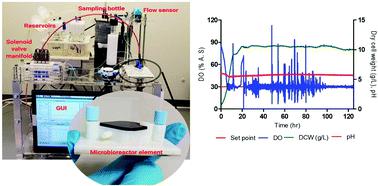Our official English website, www.x-mol.net, welcomes your
feedback! (Note: you will need to create a separate account there.)
Microbioreactor for lower cost and faster optimisation of protein production.
Analyst ( IF 3.6 ) Pub Date : 2020-08-21 , DOI: 10.1039/d0an01266a Mayur Parekh 1 , AbdulAziz Ali , Zulfiqur Ali , Simon Bateson , Fathi Abugchem , Leon Pybus , Christopher Lennon
Analyst ( IF 3.6 ) Pub Date : 2020-08-21 , DOI: 10.1039/d0an01266a Mayur Parekh 1 , AbdulAziz Ali , Zulfiqur Ali , Simon Bateson , Fathi Abugchem , Leon Pybus , Christopher Lennon
Affiliation

|
Optimisation of bioprocesses relies on approaches that are either labour intensive or require expensive robotic systems. There is a need for fluidic processing at low volume that can be integrated with existing bioprocess analytics to provide analytical information for the development and optimisation of bioprocesses. We demonstrate a 1 mL polymer inkjet 3D printed (i3DP) microbioreactor with integrated sensing (pH, oxygen and cell density) for optimisation of recombinant protein production with different feeds. A pressurised fluid driving system was used to control flow rates down to 0.7 μL min−1 with fluid switching from four reservoirs using a manifold controlled by solenoid valves. Oxygen transferred from a headspace via a gas-permeable membrane achieved a kLa of up to 90 h−1 at 1500 rpm. Cultivation of E. coli within the microbioreactor was comparable with a 2 L bench scale bioreactor, with optical densities of respectively 7.1 ± 0.4 and 6.5 ± 0.35. Triplicate batch cultivations within the microbioreactor of Pichia pastoris, with diauxic growth on glycerol (0.20 ± 0.02 h−1) and methanol (0.02 ± 0.04 h−1), showed good control of pH and DO and achieved a maximum dry cell weight of 10 ± 1 g L−1. For continuous cultivations, recombinant protein production was higher in pure methanol (314 ± 23) than methanol-sorbitol (202 ± 17) but reduces over time with lower cellular viability for methanol-glucose mixed feed, with less total protein produced and increases in DNA and proteases released. The developed system could be used in different applications including within synthetic biology, cell and gene therapy and organ-on-chips.
中文翻译:

微生物反应器可降低成本并更快地优化蛋白质生产。
生物工艺的优化依赖于劳动密集型或需要昂贵的机器人系统的方法。需要低体积的流体处理,其可以与现有的生物过程分析集成,以提供用于生物过程的开发和优化的分析信息。我们展示了具有集成感应(pH,氧气和细胞密度)的1 mL聚合物喷墨3D打印(i3DP)微型生物反应器,用于优化不同饲料的重组蛋白生产。使用加压流体驱动系统,通过使用电磁阀控制的歧管从四个储罐切换流体,从而将流量控制到最低0.7μLmin -1。从顶部空间通过透气膜传输的氧气达到了k在1500 rpm时L a可达90 h -1。培养大肠杆菌的microbioreactor内用2升的实验室规模生物反应器相当,分别7.1±0.4和6.5±0.35的光密度。在巴斯德毕赤酵母微生物反应器中进行三重分批培养,并在甘油(0.20±0.02 h -1)和甲醇(0.02±0.04 h -1)上进行双生生长,显示出对pH和DO的良好控制,最大干细胞重为10 ±1克L -1。对于连续培养,纯甲醇(314±23)中的重组蛋白产量高于甲醇-山梨糖醇(202±17),但随着时间的流逝,重组蛋白产量降低,甲醇-葡萄糖混合饲料的细胞活力降低,总蛋白产量降低,DNA含量增加并释放出蛋白酶。开发的系统可以用于不同的应用,包括合成生物学,细胞和基因治疗以及芯片上的器官。
更新日期:2020-09-14
中文翻译:

微生物反应器可降低成本并更快地优化蛋白质生产。
生物工艺的优化依赖于劳动密集型或需要昂贵的机器人系统的方法。需要低体积的流体处理,其可以与现有的生物过程分析集成,以提供用于生物过程的开发和优化的分析信息。我们展示了具有集成感应(pH,氧气和细胞密度)的1 mL聚合物喷墨3D打印(i3DP)微型生物反应器,用于优化不同饲料的重组蛋白生产。使用加压流体驱动系统,通过使用电磁阀控制的歧管从四个储罐切换流体,从而将流量控制到最低0.7μLmin -1。从顶部空间通过透气膜传输的氧气达到了k在1500 rpm时L a可达90 h -1。培养大肠杆菌的microbioreactor内用2升的实验室规模生物反应器相当,分别7.1±0.4和6.5±0.35的光密度。在巴斯德毕赤酵母微生物反应器中进行三重分批培养,并在甘油(0.20±0.02 h -1)和甲醇(0.02±0.04 h -1)上进行双生生长,显示出对pH和DO的良好控制,最大干细胞重为10 ±1克L -1。对于连续培养,纯甲醇(314±23)中的重组蛋白产量高于甲醇-山梨糖醇(202±17),但随着时间的流逝,重组蛋白产量降低,甲醇-葡萄糖混合饲料的细胞活力降低,总蛋白产量降低,DNA含量增加并释放出蛋白酶。开发的系统可以用于不同的应用,包括合成生物学,细胞和基因治疗以及芯片上的器官。











































 京公网安备 11010802027423号
京公网安备 11010802027423号